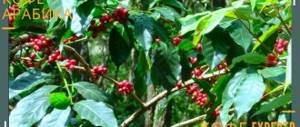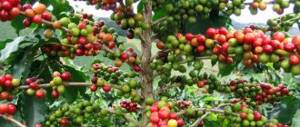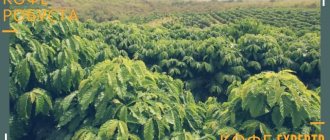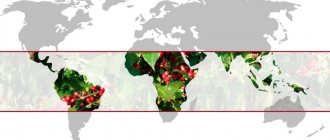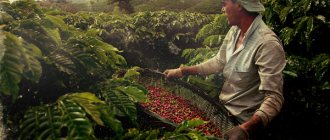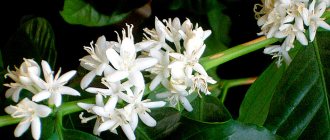Taste
At first glance, Arabica and Robusta are quite close relatives, they even belong to the same Madder family.
The main difference between Arabica and Robusta is taste. The first type is considered softer, slightly sour. Arabica can have several shades, depending on the variety:
- fruit;
- astringent, as if with spices;
- floral;
- walnut;
- chocolate;
- berry.
Robusta will appeal to connoisseurs of strong and tart coffee. After roasting, the taste becomes slightly less bitter. A characteristic feature of this type is considered to be stable volumetric foam. Robusta is suitable for espresso lovers.
Chemical composition of grains

Robusta produces a sharp, bitter, but very invigorating infusion with a faint odor. Arabica beans contain a large amount of essential oils. The percentage of their content reaches 18%. And there is only 1.5% caffeine. After roasting, the grains are valuable for vitamin PP. Arabica also contains lipids, proteins and sugars.
Robusta is translated as “strong”, since the concentration of caffeine in it is 2 times higher than in Arabica - 3%. And there are only 8% essential oils, which explains the lack of a strong smell and taste. Roasting the beans before preparing the drink softens the bitterness slightly. A high concentration of caffeine gives a good invigorating effect, and the tart taste stimulates the receptors. As a result, a person feels less tired, so this drink is usually consumed in the morning.
Popular varieties

Arabica may be mistakenly called a coffee variety. But in fact it is a type of plant. And the most popular varieties of coffee made from it include:
- Bourbon;
- Shinzan;
- Maragogyp;
- Typica;
- Bali;
- Katura;
- Aramosa.
Each variety has a characteristic taste and aroma. Arabica is very common and is considered a classic coffee, which is why there are so many varieties. There are significantly fewer varieties of Robusta:
- Conillon du Brazil (characteristic earthy flavor);
- Ambry (classic variety);
- Quilu (more often used in mixtures than solo).
Each variety was grown for its own purpose. Some reveal the taste of the drink better, while others grow and ripen faster. There are more varieties of Arabica, but Robusta also has plenty to choose from.
When is it open?

The homeland of robusta is Africa, first discovered in the floodplain of the Congo River. Arabica has been known to people since the 14th century. Since then, a large number of varieties and methods of roasting beans have appeared. But the classic taste of coffee has not changed since then.
Robusta was classified as a separate species only at the end of the 19th century. Before this, it was not drunk separately, but only mixed with others, so there was no need for identification. But now this type is highly valued by true lovers of strong coffee.
Where does it grow
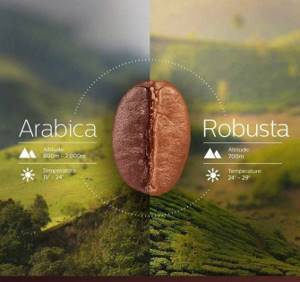
Mountain areas are better suited for cultivating Arabica. The optimal altitude above sea level for this plant is 600-2000 m. Arabica does not like heat; the optimal temperature for growth and ripening is from 15 to 24°C. Precipitation should be from 1200 to 2000 mm per year. If there are more of them, the tree may begin to rot.
Robusta trees prefer foothills and flat terrain. Robusta does not like heights too much; it is grown on land up to 800 m above the sea. But this plant requires heat and moisture. The tree grows best at temperatures from 16 to 36°C, and requires a rainfall of 2000 to 3000 mm. If climatic conditions do not meet the norm, the plant will dry out and die.
Features of cultivation
The growing altitude of Arabica coffee is 600–2200 m above sea level. Plants grow on a mountain landscape. The optimal air temperature for them is +15…+24 °C. For successful cultivation, 1200–2000 mm of precipitation is required per year.
Robusta is a tree that prefers to grow on flat terrain, rising up to 800 m above sea level. It is more demanding of heat and moisture. The optimal temperature is +18…36 °C, the annual precipitation level is 2000–3000 mm.
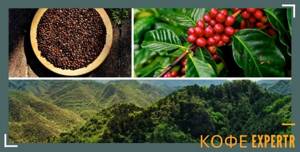
Despite the apparent unpretentiousness of arabica coffee trees, they are more difficult to cultivate. They are more susceptible to parasites, bacterial, viral, and fungal diseases. This is due to the fact that this type of coffee contains the least amount of caffeine, which prevents plants from being damaged by pests and infections.
Appearance of grains
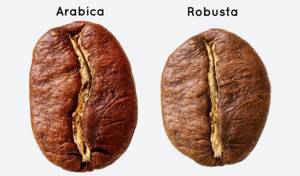
Arabica and Robusta beans differ significantly in appearance. In the first species they reach up to 8 mm and have an oval shape. After roasting, the beans have an even brown color.
The shape of the Robusta grain is closer to a circle. They are smaller in size than Arabica beans. After roasting, the color of the beans does not become uniform; they can have several shades of brown.
Plant size

Since Arabica grows in high mountain areas, it has a small trunk height. The maximum size of a tree is 5 m. In conditions of low rainfall and low temperatures, growing higher is simply irrational; the plant will not have enough nutrients.
Robusta grows in flat areas, so the tree can reach 10-12 m. Climatic conditions with high rainfall do not limit the plant in nutrients and water. And the distance from the sun's rays provokes the tree to grow in height. Therefore, Robusta is almost 2 times higher than Arabica.
Coffee trees
The Arabica coffee tree grows high in the mountains. Therefore, it grows only up to 4.5 m, less often - up to 5 m. Due to low air temperature and lack of moisture, this tree cannot achieve greater growth.
Robusta grows in places where the soil is rich in nutrients and moisture. In favorable conditions, the plant can reach a height of up to 10–12 m. But more often, tree trunks grow up to 6–7 m.
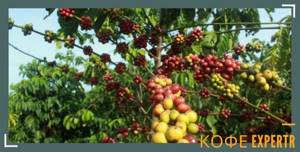
whimsicality
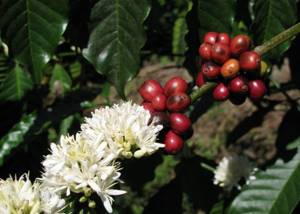
Growing Arabica is more difficult due to climatic restrictions. It can also be affected by parasites and diseases. This is due to the low concentration of caffeine, which can prevent infection.
Caring for a robusta tree is easier. It is suitable for a wider range of climatic conditions, and is also not afraid of parasites and diseases. Due to caffeine, which is 2 times more than in Arabica, pathogens do not affect Robusta beans. The yield of this species is also higher, as conditions with high rainfall suit it, which stimulates the growth and ripening of fruits.
Strong, resilient, unpretentious
Robusta or Congolese coffee (Coffea canephora) is one of the most common types of coffee tree. The name is translated into Russian as “strong” and “hardy”, and for good reason: Robusta easily rises where delicate Arabica can dry out or freeze; it is not affected by coffee diseases and is avoided by insect pests. But robusta beans contain less aromatic substances and oils, which makes it less aromatic and rich in flavor.
Congolese coffee is now grown in Brazil, Angola, Congo, Uganda, Cameroon and Asian countries, especially Vietnam, which supplies most of the world's robusta.
We have collected the most interesting opinions of tea.ru experts and tell you in what cases an unpretentious hooligan robusta with its bitter taste and nutty notes can be a better choice than its gentle “Arabian sister”.

If your work requires you to regularly wake up early in the morning, get yourself a separate jar of robusta beans and brew your first morning coffee from it. The thing is that the caffeine content in Arabica is from 0.65 to 2.7%, and in Robusta it is about 2 times more. Robusta quickly and powerfully invigorates, tones the body and relieves the feeling of fatigue.

Natural Arabica almost always has a slight (sometimes large) acidity. This is a distinctive feature of the species: the coffee berry of Arabian coffee is not similar to a cherry and is distinguished by a sweet and sour taste, which is transmitted to the beans.
Robusta may or may not be bitter, but it almost never has any sourness.

Grain differs from grain. Wild robusta, found in the foothills of the Congo, has long been changed by breeders almost beyond recognition. Preserving the natural hardiness of the plant, they developed many varieties that are distinguished by a soft and bright taste, not inferior in characteristics to Arabica. Here are some of them:
- Conillon du Brasil is a Brazilian robusta variety with an earthy aroma and a thick, rich flavor. Plays well “paired” with Brazilian Arabica.
- Java Ineak is an Indonesian robusta grown in Java.
- Ambry is an Angolan robusta that can be used as a single variety and brewed in alternative ways.
- Quilu is a rare variety of Congolese robusta that perfectly complements Arabica and gives a strong taste and brightness to the drink.
- Indian Peaberry is a grain with a balanced and mild taste and rich aroma.
- And of course, Vietnamese robusta from the mountainous province of Dalat is widely known, with its aroma of fried bread, spices and dark chocolate.
In any case, experts agree that plantation Robusta, which has been cared for with love, is much better than Arabica, which has not spent a lot of time and effort caring for. The final result is also influenced by terroir, weather conditions, harvesting and processing methods, and, of course, the degree of roasting and cooking method. Robusta, by the way, is not particularly suitable as an alternative - it is mostly beans for a coffee machine.
Important! The taste of mold, damp earth or hay is not a characteristic of robusta, but an indicator that there are grain defects. Good Robusta is neutral in taste.

Classic Italian espresso is always a mixture of different types of coffee. Arabica in this blend is responsible for the rich aroma and richness of taste, and robusta is responsible for the tonic effect, density of the drink and stable cream.
Coffee beans Panacea “Uganda Robusta”, 1000 g -30%
476 rub. 679 rub.
Bean coffee Excelso “Robusta Gold”, 200 g 669 rub.
Ground coffee Ipnosi “Robusto”, 100 g 225 rub.
Coffee capsules Di Maestri “Robusto”, for Nespresso coffee machine, 10 capsules 326 rub.
Robusta on TEA.RU
When choosing a mixture, be guided by the percentage of each type of coffee it contains:
- The proportion of 90% Arabica to 10% Robusta produces a gentle coffee with an invigorating effect.
- 80% to 20% – thick, dense coffee, in which there is room for both sourness and light characteristic bitterness.
- 70% to 30% is a strong, rich drink without sourness, it tones well and saturates the body with antioxidants.
- 60% to 40% is the best option for those who like “to make it stronger.” Taste with pronounced coffee bitterness, without sweetness or sourness.

If you prefer freeze-dried coffee, chances are you're drinking Robusta with Arabica (and not the other way around). Instant coffee is made from inexpensive robusta, so you shouldn’t expect a wonderful taste from it, but it does an excellent job of “wake up” the function.
Usage

Arabica and Robusta differ in purpose. The first type is used in its pure form; an aromatic, weak drink is prepared from it. And the second is suitable for espresso, as it has a powerful invigorating effect. It is also added to mixtures for making coffee, and is also used as a base for creating instant drinks. Robusta is drunk in its pure form only by true connoisseurs who like its bitterness and tart taste.
Which type of coffee is better: Arabica or Robusta?
Coffee has become the favorite drink of billions and has become an image. It relieves fatigue, invigorates, speeds up brain function. A pleasant aromatic drink with a hint of bitterness can be drunk at any time.
The world's most famous manufacturers use mainly two varieties of coffee to produce their products: Arabica and Robusta. The remaining coffee varieties are not of particular value, are inferior in taste and are not used for industrial purposes.
Arabica coffee variety Arabica coffee variety loves warm, humid climates and high mountain slopes near the sea. Coffee trees grow in moist, nutrient-rich soils and do not tolerate sudden temperature changes. They require attention and care. The crop is usually harvested twice a year. But if the tree grows at an altitude of more than one thousand meters, the caffeine content in the beans decreases. Plants are very sensitive to soil fertility, mineral fertilizing, and are not resistant to pests. The Arabica coffee variety is divided into types. There are about fifty of them, but two can be called the most famous and grown: - Bourbon - the most productive type grown; — Maragogype is attractive because of its large coffee beans. The tree's annual yield is not large, no more than one kg in total. Despite all the whimsical and demanding plants, Arabica coffee plantations are the most grown in the world.
Robusta coffee variety Robusta coffee plantations are several times inferior to Arabica in terms of cultivated area. They are less demanding, but enjoy year-round warm temperatures and moisture. Robusta grows at lower altitudes and in valleys. The tree is less demanding on soil and resistant to diseases. It requires less cash investment. The majority of robusta plantations are located on the African and Asian continents.

Differences between Arabica and Robusta Coffee beans, which contain only 100% Arabica, are the most expensive drink, distinguished by its aroma and taste. Using various roasting methods, coffee drinks with rich flavor characteristics differ from each other in taste. The main problem is to preserve the aroma after this, because it quickly evaporates. Arabica is valued for its high content of oils, sugars and lipids and its low astringent taste. Robusta contains a lot of caffeine and due to this it has a bitter taste and greater strength. In terms of taste and aroma, it is several times inferior to Arabica. It is not used to prepare a coffee drink in its 100% form. Such a drink will have no value and will not bring profit. The cheapness of Robusta coffee beans is due not only to their low taste, but also to the low demands of the trees themselves.
What to choose: Arabica or Robusta? Every coffee lover will answer this question: Arabica. But in its pure form it is rarely offered for implementation. Arabica and Robusta varieties are mixed. The percentage ratio of beans in each coffee drink is different from others. Due to this, they turn out to be different in taste and quality. Robusta, as an additive, is used to reduce the price. But at the same time, the caffeine content increases and a strong, stable foam is obtained. The most popular option is 80% Arabica and 20% Robusta. The high content of amino acids in robusta gives its taste bitterness and viscosity. To reduce these disadvantages, its grains are subjected to special treatments.
Mixed types of coffee drinks are of greatest interest and popularity among gourmets. Arabica and Robusta beans complement each other favorably in taste and aroma. The choice is huge!
Cost of Arabica and Robusta
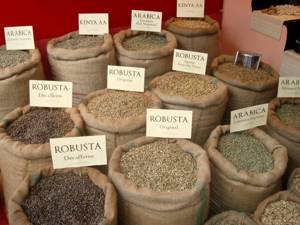
The price of arabica is usually higher than that of robusta. This is due to the peculiarities of growing the species, as well as its taste characteristics. But there are also expensive, rare varieties of Robusta. Although the average cost of this type is several times lower compared to Arabica. This is explained by the low taste of robusta and the unpretentiousness of the tree to external conditions.
Arabica and Robusta are different types of coffee, each of which includes several varieties. They are completely different in taste, and their climatic and geographical conditions are completely different. Therefore, it is not difficult to make a choice between Arabica and Robusta, you just need to try them.
Famous brands make their products from these two types of coffee: Dallmeier, Lavazza, Carte Noir, Paulig, about which you can learn a lot of interesting and useful information on our website.
Differences between Arabica and Robusta
First of all, you need to distinguish between concepts such as “type of coffee” and “grade of coffee”. It would be incorrect to call Arabica and Robusta, as well as less common types of coffee - Liberica and Excelsa, coffee varieties. These are all species of the coffee tree, each of which has a certain number of varieties used for the commercial production of the popular drink.
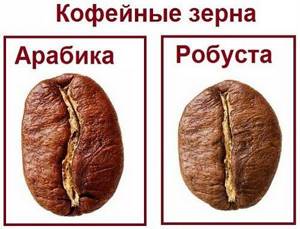
There are 9 main differences between Arabica and Robusta:
- Coffee bean shape . Arabica beans have an elongated oval shape. Robusta beans are typically smaller than Arabica beans and have a more rounded shape.
- Cultivation conditions . Both types of coffee require different growing conditions. So Arabica is grown much higher than Robusta - this is from 600 to 2200 meters above sea level, and Robusta grows up to 800 meters above sea level. In addition, robusta requires a more humid and warm climate. For example, comfortable climatic conditions for robusta are 18-36 degrees Celsius, with an annual precipitation of 2000-3000 mm, while Arabica is less demanding - 15-24 degrees Celsius, with 1200-2000 mm of precipitation per year, respectively.
- Coffee tree size . The height of the Arabica tree is shorter than that of the Robusta tree. Arabica can reach a height of up to 4.5 meters, in contrast to the Robusta tree, which can grow up to 6 meters.
- Genetic differences . Arabica has 44 chromosomes, versus 22 in Robusta.
- Chemical composition of coffee beans. Robusta contains twice as much caffeine as Arabica, which directly affects the tonic properties of the drink. However, due to the lower content of sucrose and higher amounts of chlorogenic acid compared to Arabica, Robusta coffee cannot boast of good taste and aroma. Most often, Robusta is used as an additive to Arabica to increase the caffeine content in a mixture of these two types of coffee.
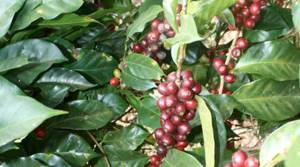
- Difficulty in growing a tree . Robusta wood is less demanding to care for than Arabica wood. With lower cultivation costs compared to Arabica, Robusta produces a larger grain yield that is less susceptible to disease and damage by insects due to the high content of caffeine and chlorogenic acid.
- Price . Due to lower cultivation costs, the price of Robusta grain is almost two times lower than Arabica grain. True, the organoleptic qualities are also two times lower than Arabica.
- Arabica and Robusta flavours . As noted earlier, the taste qualities of both types of coffee come from the chemical composition of the bean. Roasted Robusta is more bitter, due to the high content of caffeine and chlorogenic acid, which is not present in Arabica, which has a characteristic sourness and aroma due to the higher amount of sucrose and lipids than in Robusta. The taste of a drink made from pure Robusta can be described as “rough” without any shades or nuances, unlike Arabica, which can have many shades of taste and aroma, depending on the variety and processing conditions.
- Use of Robusta and Arabica . As a rule, Robusta is used in mixtures with Arabica in various proportions to increase the proportion of caffeine and also reduce the cost of the finished product. In addition, large quantities of Robusta beans are used to make instant coffee. If you regularly drink inexpensive instant coffee, then you can confidently say that it is made with a maximum proportion of robusta and a minimum of Arabica.

